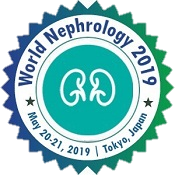
Kuo-Cheng Lu
Fu-Jen Catholic University Hospital
Title: Role of nutritional vit-D in secondary hyperparathyroidism
Biography
Biography: Kuo-Cheng Lu
Abstract
In chronic kidney disease (CKD), hyperphosphatemia induces fibroblast growth factor-23 (FGF-23) expression that disturbs renal 1,25-dihydroxy vitamin D (1,25D) synthesis; thereby increasing parathyroid hormone (PTH) production. FGF-23 acts on the parathyroid gland (PTG) to increase 1α-hydroxylase activity and results in increase intra-gland 1,25D production that attenuates PTH secretion efficiently if sufficient 25D are available. Interesting, calcimimetics can further increase PTG 1α-hydroxylase activity that emphasizes the demand for nutritional vitamin D (NVD) under high PTH status. For the high prevalence of vitamin-D deficiency (VDD) in hemodialysis patients, an increase in 1α-hydroxylase to 10-fold and decrease in 24-hydroxylase to 1/10-fold highlight the requirement of more 25D in the PTG of SHPT. The expression of CaSR and VDR were also decreased in the PTG cells, which is thought to be related to calcimimetics or calcitriol resistance. A higher proportion of oxyphil cells as hyperplastic parathyroid progression, lower cytosolic DBP content in oxyphil cells, and calcitriol promote vitamin D degradation by enhancing 24-hydroxylase activity all aggravate vitamin D hunger in PTG. Hence, NVD supplementation in SHPT is relative important. Clinically, NVD supplements can effectively restore serum 25D concentration, alleviate the development of SHPT in early CKD, and have benefits in further lowering PTH in moderate to severe SHPT in dialysis patients. However, these benefit of NVD supplement in SHPT need more randomized control trials to prove.

